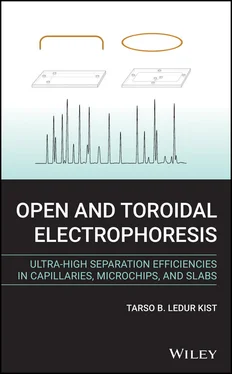1 Cover
2 Preface Preface The main goal of this book is to present electrokinetic based separation techniques in a didactic and concise manner, making the content accessible to the broadest possible audience (students, users, and researchers). In addition, this book provides the exact expressions of separation efficiency, resolution, peak capacity, and many other performance indicators. Appropriate illustrations are presented, and the underlying fundamental phenomena and models are discussed in a logical order instead of in a chronological order. Chemical and physical insights are also developed by emphasizing the microscopic scenarios of the molecular processes involved. Important mathematical relationships are given to aid users with their practical applications and theoretical studies of the dozens of separation modes performed in the three most common platforms: capillaries, microchips, and slabs. The two most important layouts of these three platforms are also described and compared: the conventional open layout, with an inlet and an outlet for the samples, and the toroidal or closed loop layout, where samples run in a quasi -continuous circulating mode until the desired resolution is obtained. Motivation to write this book came from twenty years of teaching both undergraduate and graduate students, as well as from stimulating collaborations with so many bright and talented colleagues, to all of whom I am deeply grateful. The author is thankful to Dr C. Heller, Professor J. H. Z. dos Santos, Professor C. L. Petzhold, Professor A. Manz, Professor Bingcheng Lin, Professor B. Gaš, Professor J. W. Jorgenson, and Professor H-P. Grieneisen for their helpful discussions and suggestions. Additionally, the author is grateful to E. J. M. Bradley for proofreading the manuscript. Finally, it must be mentioned that these people should not be blamed for the errors the author insisted on keeping in this book! January, 2020 Tarso B. Ledur Kist Porto Alegre
3 Acronyms
4 Symbols and Conventions
5 Introduction
6 1 Solvents and Buffer Solutions1.1 Water as a Solvent 1.2 Binary Mixtures and Other Solvents References
7 2 Fundamentals of Electrophoresis2.1 Introduction 2.2 The Platforms 2.3 Electrophoresis 2.4 Electrophoresis of Single Molecules 2.5 Ionic Limiting Mobility 2.6 Bands, Fronts, Peaks, and Zones 2.7 The Isoelectric Point 2.8 Turbulent and Laminar Flow 2.9 Electroosmosis 2.10 Supression of EOF 2.11 Joule Effect and Heat Dissipation 2.12 Temperature Profiles 2.13 Molecular Diffusion and Band Broadening 2.14 Sample Stacking and Band Compression 2.15 Separation Modes References
8 3 Open Layout3.1 Introduction 3.2 Capillary Electrophoresis 3.3 Microchip Electrophoresis 3.4 Slab Electrophoresis 3.5 Performance Indicators for Open Layouts References
9 4 Toroidal Layout4.1 Introduction 4.2 Toroidal Capillary Electrophoresis 4.3 Toroidal Microchip Electrophoresis 4.4 Toroidal Slab Electrophoresis 4.5 Folding Geometries 4.6 Microholes and Connections 4.7 Reservoirs 4.8 Active and Passive Modes of Operation 4.9 Performance Indicators for Toroidal Layouts References
10 5 Confronting Performance Indicators5.1 Introduction 5.2 Performance Indicators from Experimental Data 5.3 Performance Indicators Predicted from Operational Parameters References
11 6 High Voltage Modules and Distributors6.1 Introduction 6.2 High Voltages in Open Layouts 6.3 High Voltages in Toroidal Layouts References
12 7 Heat Removal and Temperature Control7.1 Introduction 7.2 Temperature Gradients are Unavoidable 7.3 Temperature has Multiple Effects 7.4 Electrical Insulators with High Thermal Conductivity 7.5 Cooling Strategies Used in Capillary Electrophoresis 7.6 Cooling Strategies Used in Microchip Electrophoresis 7.7 Cooling Strategies Used in Slab Electrophoresis 7.8 Shear Rate of the Coolant 7.9 Final Considerations References Note
13 8 Detectors8.1 Introduction 8.2 Fixed Point Detectors 8.3 Spatial Detectors (Scanners and Cameras) 8.4 Derivatization Reactions References
14 9 Applications of Toroidal Electrophoresis9.1 Introduction References
15 Appendix A: Nomenclature References
16 Appendix B: Species Concentration in Buffer Solutions B.1 Acids (H nA) B.2 Bases (B) References
17 Appendix C: Electrophoresis C.1 Free-Solution Electrophoretic Mobility C.2 Mobility Dependence on Temperature C.3 Transient Regimes References
18 Appendix D: ElectroosmosisD.1 Slab and Microchips – Cartesian Coordinates D.2 Capillaries – Cylindrical Coordinates D.3 Zeta Potential References
19 Appendix E: Molecular DiffusionE.1 The Diffusion Equation E.2 The Propagator E.3 Application of Propagators to Bands at Rest E.4 Application of Propagators to Bands in Movement E.5 Bands and Peaks References
20 Appendix F: Poiseuille Counter-flowF.1 Introduction F.2 Velocity Level Contours F.3 Temperature Level Contours F.4 Equalizing  and
and  Reference
Reference
21 Appendix G: Cyclic On-column Band CompressionG.1 Introduction G.2 Effect of Cyclic Band Compression Events on Variance G.3 Number of Theoretical Plates G.4 Number of Theoretical Plates per Unit Time G.5 Height Equivalent of a Theoretical Plate G.6 Resolution G.7 Resolution per Unit Time G.8 Band Capacity G.9 Band Capacity per Unit Time G.10 Detailed Calculation of  and
and  References
References
22 Index
23 End User License Agreement
1 Chapter 1 Table 1.1 Relative (static) permittivities of liquids at 20  C. Extracted from Wo... Table 1.2 Examples of some LogP values. These are the average values of the
C. Extracted from Wo... Table 1.2 Examples of some LogP values. These are the average values of the  mos...
mos...
2 Chapter 2Table 2.1 Values of the dimensionless parameters  and
and  of equation 2.21, given ...Table 2.2 Troubleshooting checklist to reduce band dispersion in ESTs.Table 2.3 Procedures to reduce peak width caused by factors other than band disp...Table 2.4 The most appropriate separation modes for each class of analytes when ...
of equation 2.21, given ...Table 2.2 Troubleshooting checklist to reduce band dispersion in ESTs.Table 2.3 Procedures to reduce peak width caused by factors other than band disp...Table 2.4 The most appropriate separation modes for each class of analytes when ...
3 Chapter 3Table 3.1 Parameters extracted from band/peak 1.Table 3.2 Parameters extracted from band/peak 2.
4 Chapter 5Table 5.1 Performance indicators (PIs) and the procedure used to calculate them ...Table 5.2 Summary of the performance indicators of the open and toroidal layouts...Table 5.3 Summary of the performance indicators in terms of applied voltage (  )....Table 5.4 Summary of the nine performance indicators (PI) without the operationa...Table 5.5 Summary of the performance indicators expressed in terms of the number...
)....Table 5.4 Summary of the nine performance indicators (PI) without the operationa...Table 5.5 Summary of the performance indicators expressed in terms of the number...
5 Chapter 7Table 7.1 List of operational parameters that are affected by temperature and th...Table 7.2 List of acids and bases with their thermodynamic  values, apparent (wo...Table 7.3 List of properties that are important for the efficient performance of...
values, apparent (wo...Table 7.3 List of properties that are important for the efficient performance of...
Читать дальше

 and
and  Reference
Reference and
and  References
References C. Extracted from Wo... Table 1.2 Examples of some LogP values. These are the average values of the
C. Extracted from Wo... Table 1.2 Examples of some LogP values. These are the average values of the  mos...
mos... and
and  of equation 2.21, given ...Table 2.2 Troubleshooting checklist to reduce band dispersion in ESTs.Table 2.3 Procedures to reduce peak width caused by factors other than band disp...Table 2.4 The most appropriate separation modes for each class of analytes when ...
of equation 2.21, given ...Table 2.2 Troubleshooting checklist to reduce band dispersion in ESTs.Table 2.3 Procedures to reduce peak width caused by factors other than band disp...Table 2.4 The most appropriate separation modes for each class of analytes when ... )....Table 5.4 Summary of the nine performance indicators (PI) without the operationa...Table 5.5 Summary of the performance indicators expressed in terms of the number...
)....Table 5.4 Summary of the nine performance indicators (PI) without the operationa...Table 5.5 Summary of the performance indicators expressed in terms of the number... values, apparent (wo...Table 7.3 List of properties that are important for the efficient performance of...
values, apparent (wo...Table 7.3 List of properties that are important for the efficient performance of...










